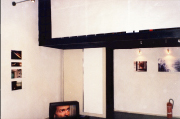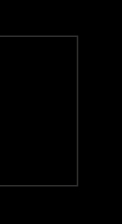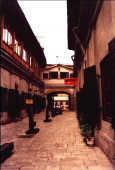Since we decided to have this magazine, we waited for something really important to happen in Bucharest, among all the dusty exhibitions and art events "aborted" because of heat. However, it seems that some people's expectances are still too large comparing to what others can offer, so, when I found out that a multimedia gallery is opening (extra-season), I was taken by surprise. That's it, that's what I'm writing about. We are going to see something else; a reality known only by magazines or by the Internet - finally here, accessible, visible, contemporary with the world we're aspiring to. If things are this way or not, it's up to you to decide. What I have seen resembles more to a project in progress, of some good, enthusiastic artists, but too concerned about not "losing the opportunity". Why? because here everything is negotiable in terms of "now or never" and we have been surviving for 2000 years under the moment's sign, without wanting more, without perspective.
Simona Nastac: What is it and how was it
born HT003?
Teodor Graur: HT003 is a contemporary art gallery run by a group of artists
- Iosif Kiraly, Gheorghe Rasovszky and Teodor Graur. It is related, also,
to the founding of the multi-media department within the Romanian Artists
Union, which is supporting us directly, by offering this location in Hanul
cu Tei 22. The main idea was to open a gallery for the new media (a current
issue for the artists all over the world and, of course, for the artist here);
but we thought to extend our options. In fact, we want to exhibit contemporary
art as approach, no matter the technique, henceforth we'll have also painting,
installation and many, many others.
S.N.: Still, multimedia art in Romania has already a history (maybe older
than 25 years, from the first photo experiments - photomontage, photo-installations,
interventions on photopraphy, then videos and intermixtures between the different
media); even the term changed from intermedia to multimedia or mixed-media.
Isn't this a proof that the Artists Union ignored this tendency until now,
and when it finally reacted, didn't perceive it appropriately, in that it
didn't offer a more adequate space?
Gheorghe Raszovski: The Union can't do more at this moment because it has
only a few locations. In the beginning we were promised a much better space,
the former office of Arta magazine… But this is less important; it's
like you would say that you wear a shoe size 35 instead of 37, when you could,
in fact, wear a 65. Romania has no spaces for this, and the Union is testing,
probably, what could happen with a gallery like this, and maybe it will, at
a certain time, do some more efforts. It's not about a bad synchronization;
the Union has a policy adjusted for the classical approaches and this thing
done by the Union now is a happy "omission" which we are trying
to speculate, not for us, but for all the artists preoccupied with multimedia.
S.N.: Although the intention is to praise, I insist in stating that this space
is not appropriate. It is located amongst all the other commercial galleries
and nothing reflects the fact that something different happens here. Don't
you think that a multimedia gallery should have looked differently in 2003?
G.R.: At this moment, there are no means for such a thing and all that can
be done is by individual effort. There are sponsors, but they are in abeyance:
they want to see how things are developing and they are not quite interested
in this. Besides, accompanying a widespread ignorance, there is no frame in
favor of sponsoring this type of events.
T.G.: I have to say it again: this gallery is the initiative of a group of
artists who are members of the Union, but, in this case, the Union is just
a sponsor for us, not a framework within which to develop our projects. There
are and there will be all kind of discontinuances, especially between the
Romanian and the western art. They can't be eliminated and there's nothing
wrong about this, as it would be boring to see the same kind of art everywhere.
Anyway, I think this is quite an adequate space, even if the walls are not
perfect or something like this…
S.N.: Honestly, I'm tempted to link the opening of this gallery to that of
GAD photogallery in 1993. But then the space had been chosen deliberately
to have an underground and improvised look, in order to reflect the poor condition
of photography in Romania, at that moment. Did you have a similar intention
about HT003?
T.G.: We started with what we had to present and people came to the opening
as they knew us, and everything was quite normally. We didn't intend to shock
or to raise polemics, although the announcements posted on "nettime-ro"
were more aggressive.
G.R.: There is something more to add. The critics expect special spaces, endowed
occidentally, thinking at this to be a solution. However, the artists are
the problem. That's why, in my opinion, it's not so important that a space
looks sharp. Finally, we hope that the artists who exhibit here are very good.
Each artist can come with a technological surprise, that can change completely
the look of the gallery. So, it's something possible and workable. Still,
the main goal of this gallery is to provide an alternative for the artists
who are in queue for "Simeza" gallery or for others. The normal
way would be that, after some major events happen here, we can discuss upon
the re-arranging of the space.
S.N.: The title of the present exhibition, "Looking for heroes",
refers also to the strategy or the adventures of the gallery's opening? Is
this a heroic, brave act? If it is, related to what? To the Union's birocracy,
to the public apprehension or to yourself?
G.R.: We, those who are doing these things, have all some certain features
to be found in this title. It's a permanent issue, that, at the same time,
has both an amount of black humour and some sense of raw reality. It's a subject
we've adapted to, not transforming it into a manifest. What we did quite open
was the text where we explained that we didn't reject anything at all. To
reject poverty and the minimal means of the Romanian artists who are trying
to do something would be useless. The important thing is that the artists
exhibit very good works.
T.G.: It is important that the artists have initiative and projects. In fact,
this is how things are going with contemporary art: to have projects and to
apply all the time, trying to make them work, to find sponsors and means.
S.N.: Yes, but in this way, the artist becomes manager and who is to make
art anymore?
T.G.: Art is the outcome of that. We don't know if it is at, what's its value
etc.. It's not us to judge, but the public and the critics.
S.N.: About this condition of permanent hero, I remember your work, the Carpathians
hero, made with Olimpiu Bandalac and presented at the Istanbul biennial in
1995. This work was a parody of our identity stereotypes comparing to the
rest of the world, and I'm wondering which is the point of the present exhibition,
almost 10 years after Istanbul? You count again on the specificity of your
artist condition, don't you?
T.G.: What we want to do here is more than to exhibit our own works. We want
to be more active and more visible in the Romanian society. If all the artists
are concerned only with their projects, or leave, here it will be a void for
the public.That's why we'll try, firstly, to bring in this gallery Romanian
works that were exhibited in the West, that are not known here, if only by
some catalogues and magazines. Secondly, I think that what is missing on the
Romanian contemporary art scene is an important biennial or other major event
where the public could come to be in direct contact with the art. For this,
it is necessary the involvment of some institutions, the Romanian government,
"weighty" banks, etc…
S.N.: And what do you do for this?
T.G.: Well, we have done "Art and democracy" in Timisoara in 1990,
"Food for art, art for food" in '90, in front of "Dalles"
gallery, where we begged and raised money and some poor people ate there…
It wasn't just irony or sel-irony, it was something really serious.
S.N.: I think this kind of actions would still be of interest today, and maybe
it would change something… But, coming back to the exhibition you've
opened the gallery with, I want to ask you, why the first invited artist was
Ionica Grigorescu?
G.R.: Ionica Grigorescu is an European artist of equal value to the best European
artists of the moment. There was in the '80s an experimental art group, which
eventually disappeared, formed of Paul Neagu, Iulian Mereuta and others, who,
had they stayed in Romania, it would have been very good, for us and for them
too. It didn't happen that way. Ionica Grigorescu stayed, and he represents
a constant reference point in Romanian contemporary art. He is, for us, a
symbol of the fact that time, conditions, governments and political systems
are of no importance, when the artist has the strength to do what he has to
do, without paying attention to what is happening around him.
S.N.: But the artist is interested in all that happens, as he wants to communicate,
art is language. Besides, there is a strong potential of social interaction
of art, which has to be used by the artist, even in subtext, otherwise his
approach would be useless. Even the written manifest of your exhibition proves
the involvment, not the detachment; and not only aesthetically, but also politically,
ideologically, socially.
G.R.: This is an inner criterion of an artist, but those who take this as
the substance of their work come to theorizing too much and start working
lesser and lesser. Or, an artist has to have major achievements not only in
quality but also in quantity. People are getting bored with concepts, and
the most recent example is the Venice Biennial, where the spleen is ruling
this year.
S.N.: As you brought into question the biennials, why do you think that in
the last years Romania hasn't been invited to take part to these events, apart
from Venice, of course?
T.G.: We have. In 2002, in Graz, at the exhibition "In Search of Balkania"
- with subREAL, Teodor Graur, Ionica Grigorescu; and this year, in Vienna,
at the exhibition "Blood & Honey", organized by Essl Collection
in Klosterneuburg, still with subREAL and Patricia Teodorescu. There are important
shows, of the same importance with the biennials. But for the biennials we
need recognized curators, as Harald Szeeman or Carlo Politi, to invite us.
Or, this is like a francmason order, the relationships are clannish, you cannot
be a member if you're not invited, and there's nothing you can do about this.
S.N.: One last question, about HT003. Is this gallery going to bring a change
of perspspective unpon the multimedia art here? In the sense of a renewal,
maybe a more aggressive, more noticeable, more dinamic spirit? What projects
do you have for the next future?
T.G.: Two personal shows are to come: Vlad Iacob, in September, a valuable
artist, who didn't manifest himself publicly until now; then Stefan Rusu,
a young artist from Chisinau, who has settled in Romania and has a very special
relationship with the artists from the Far East. As an artist, he does video,
sculpture, installation, literature, concepts, film, but he also has interesting
projects as curator, one of these being "InvAsia". Then we'll have
Emilian Savescu with photo and Gheorghe Raszovschi with a new concept, that
we are anxiuosly waiting for. We'll bring here also artists portofolios and
"Avangart" films and all the necessary materials to compose a small
archive of multimedia Romanian art, so I think the gallery has all the ingredients
for success.
G.R.: And, mostly as a coincidence, the 11 episodes of the "Avangart"
TV show which I did until now reflect the same thing: there are artists who
succeed.
T.G.: If we can't make it with HT003, we'll open a café.
S.N.: Multimedia, I suppose… Thank you.















